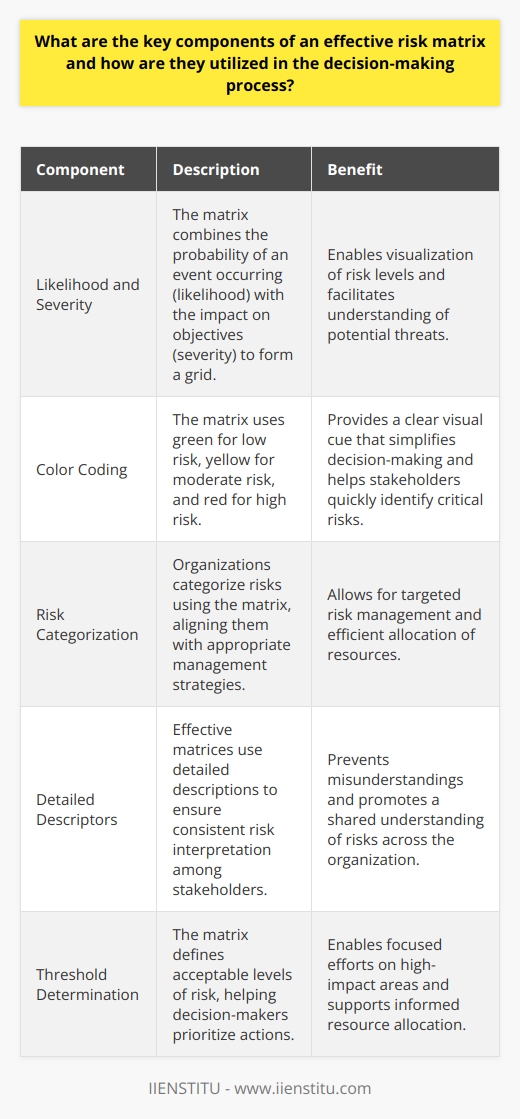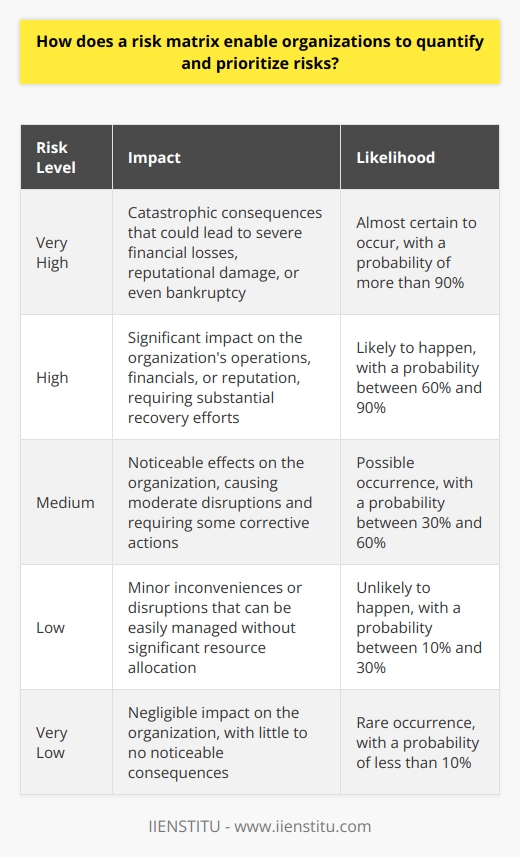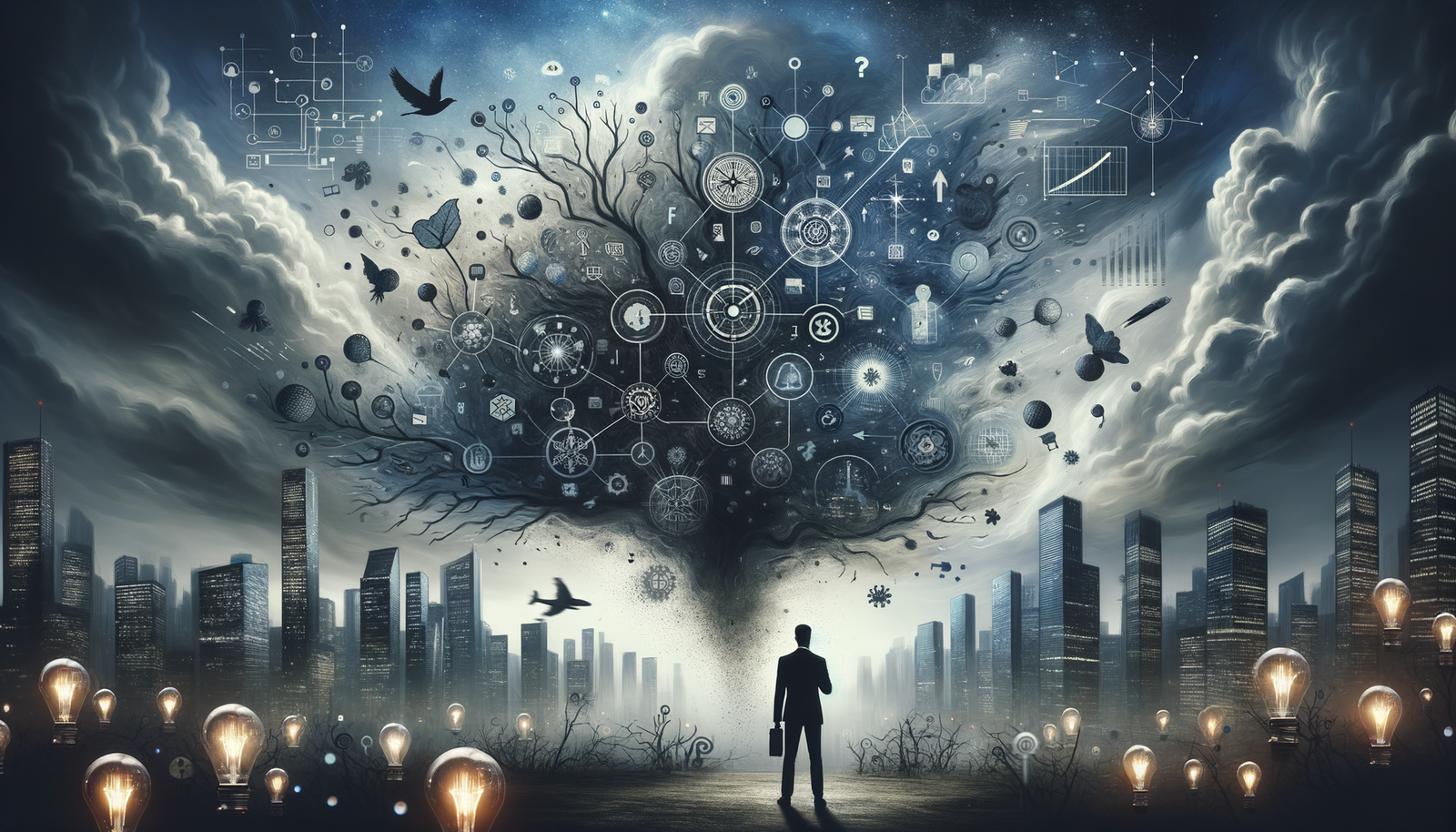
The utilization of a Risk Matrix in decision-making processes across various sectors has become an indispensable tool in the modern business environment. This comprehensive guide serves to elucidate the intricate aspects of a Risk Matrix, detailing the quintessential elements involved in its construction and execution. With a pivot towards experiential learning and practical application in a range of disciplines, this article endeavors to embed a robust understanding of how a Risk Matrix can be an effective instrument for those seeking to learn problem solving techniques and mitigate potential risks before they burgeon into unmanageable dilemmas.
Understanding the Elements of a Risk Matrix
Risk management is a multidimensional field requiring a profound understanding of the various elements that constitute a Risk Matrix. It is this very understanding that underpins the capacity to anticipate, evaluate, and mitigate risks in a multitude of contexts.
Explanation of Risk Severity
In the domain of risk management, the term Risk Severity refers to the extent of damage or negative consequences that could emanate from a given risk. To adeptly calculate this metric, one must consider both the qualitative and quantitative aspects that could contribute to the possible impact. This might involve statistical analysis, expert judgement, or historical data interpretation.
Real-world examples include assessing the severity of cybersecurity breaches in terms of potential data loss, or gauging the impact of a faulty product release in terms of customer dissatisfaction and financial loss.
Understanding Risk Probability
The concept of Risk Probability pertains to the likelihood of a risk actually manifesting. Methodologies to estimate this component typically range from predictive models and statistical analysis to expert opinion, each providing an estimation of probability with varying degrees of precision. The reliability of these predictions significantly shapes the management strategy implemented.
For instance, a pharmaceutical company might use clinical trial data to estimate drug side effects, while an investment firm may apply financial models to ascertain the probability of market fluctuations.
Discussing Risk Impact
The notion of Risk Impact goes hand in hand with Risk Severity, denoting the actual ramifications of a risk should it occur. Assessing Risk Impact involves taking into account both tangible and intangible factors, a multifaceted approach that could encompass financial metrics, brand reputation, legal compliance, and personnel morale.
Comprehensive Guide To Strategized Initiatives And Expert Tactics
Problem Solving Skills With Total Systems İntervention Strategies
For example, a factory's response plan to a potential environmental spill must consider not just cleanup costs but regulatory repercussions and public image.
Steps to Create a Risk Matrix
The creation of a Risk Matrix is a strategic process that demands a meticulous approach to identify, assess, and prioritize potential risks. This ensures that resources are allocated effectively to address the most significant threats.
Identifying potential risks
The initial step is to conduct an exhaustive risk identification exercise. This involves brainstorming sessions, expert consultations, and the analysis of historical data within the organization and the industry at large. It is critical to leave no stone unturned, as unrecognized risks can lead to unpreparedness and hence, more severe consequences.
Assessment of Risk Probability
Once risks have been identified, organizations must undertake the task of assigning a probability score to each risk. This step is crucial as it helps in gauging which risks are more likely to occur and hence should be paid more attention to. Employing both qualitative and quantitative methods ensures a comprehensive evaluation of the likelihood of each risk.
Evaluation of Risk Severity
Subsequent to the assessment of probability, establishing the severity of each risk aligns with understanding the extent of impact it may have. This dichotomy between probability and severity is the salient feature of the matrix, allowing for a prioritization of risks that are both likely to happen and have serious consequences.
Determination of Risk Impact
Once risks have been identified and their severity assessed, determining the potential impact on the organization is the logical progression. This involves not only the immediate effects but also the long-term implications on operations, financial health, and stakeholder relationships.
Prioritization of risks based on matrix data
The culmination of the prior steps is the prioritization of risks based on the synthesized matrix data. This provides a clear picture of which risks demand immediate attention and resources, thus allowing for an efficient and focused risk management strategy.
Advantages of Utilizing a Risk Matrix
The robust implementation of a Risk Matrix offers a plethora of advantages to organizations seeking to enhance their decision-making prowess and risk management capabilities.
Importance in decision-making process
The Risk Matrix is paramount in guiding the decision-making process, distilling complex risk information into a digestible format. It facilitates an understanding of possible scenarios and the ability to prepare and react accordingly. This proves invaluable in strategic planning and resource allocation.
Role in developing effective risk management strategies
When it comes to crafting effective risk management strategies, a Risk Matrix serves as a foundational tool. It helps in recognizing the weakest links and potential fallout within operations, prompting the development of mitigation plans and response protocols.
Benefits of visual representation and ease of understanding
One of the most significant benefits derived from a Risk Matrix is its visual representation. The matrix layout simplifies the relationship between probability and impact, making it easily understandable by stakeholders across various levels of the organization. This clarity enhances communication and consensus during risk planning sessions.
Challenges and Limitations of a Risk Matrix
Despite its usefulness, it's important to recognize that a Risk Matrix is not without its challenges and limitations.
Understanding subjective ratings
One of the critical challenges in using a Risk Matrix is the subjectivity that often clouds the ratings for probability and severity. Different individuals or teams may interpret risks differently, leading to varied responses that could affect consistency in risk management strategies.
Risks of over-simplification
A Risk Matrix simplifies complex realities into a two-dimensional framework, which can sometimes lead to an over-simplification of risks. This reductionist approach may overlook nuances and interactions between risks that could be significant in certain scenarios.
Probability-impact paradox
There exists a paradox where high-impact risks with low probability are often undervalued compared to high-probability, low-impact ones. Striking a balance in assessing and acting on these disparate risks is a nuanced challenge.
Dealing with multiple risks
The concurrent presence of multiple risks complicates their representation on a single Risk Matrix. This can lead to confusion in priority-setting and resource allocation, as risks may interact with, amplify, or negate each other.
Case Study: Applying Risk Matrix in Real-world Scenarios
Case studies serve as illuminative examples of how the theoretical aspects of a Risk Matrix are implemented in practical scenarios, demonstrating tangible benefits and challenges.
Case study in project management
In project management, the application of a Risk Matrix can significantly enhance the likelihood of a project's success. For instance, a construction project would use a Risk Matrix to evaluate potential delays, budget overruns, and safety hazards, leading to proactive measures such as alternative sourcing, fund allocation, and safety training.
Risk matrix in the field of Health and Safety
The field of Health and Safety may employ a Risk Matrix to manage workplace hazards effectively. By categorizing risks from machinery mishaps to chemical exposures and designing targeted control measures, health and safety officials can improve worker safety and compliance with regulations.
Application in financial and investment decisions
In financial and investment decision-making, a Risk Matrix provides a structured approach to identify risks such as market volatility, credit risk, and liquidity concerns. Investment portfolios can thereby be adjusted based on a clear understanding of these risks, optimizing returns while mitigating potential losses.
In conclusion, the utility and importance of a Risk Matrix in enhancing decision-making and risk management practices cannot be overstated. It offers a structured and systematic approach to a complex problem, allowing organizations to focus on the most pressing risks. Whether in project management, health and safety, or financial planning, the Risk Matrix is an essential tool. As such, varied use across industries should be encouraged, and understanding its proper application should be disseminated—potentially through online certificate courses. This guide not only underscores the theoretical underpinnings of the Risk Matrix but also highlights the experiential learning that accompanies its real-world utilizations. An enterprise equipped with this knowledge is well-positioned to navigate the unpredictable waters of operational risks and emerge more resilient and informed.
Frequently Asked Questions
What are the key components of an effective risk matrix and how are they utilized in the decision-making process?
Key Components of an Effective Risk Matrix
Defining Risk Matrix
A risk matrix assesses potential threats. It aids organizations in understanding and managing risks. Stakeholders use it to make informed decisions.
The Matrix Structure
The risk matrix combines two elements:
- Likelihood
- Severity
Likelihood refers to the probability of an event occurring. Severity measures the impact on objectives. These dimensions form a grid, enabling visualization of risk levels.
Color Coding for Clarity
Color coding enhances the matrix:
- Green for low risk
- Yellow for moderate risk
- Red for high risk
This visual cue simplifies decision-making.
Risk Categorization
Organizations categorize risks using the matrix. Categorization aligns risks with management strategies.
Detailed Descriptors
Effective matrices use detailed descriptors. Descriptions ensure consistent risk interpretation. They prevent misunderstandings among stakeholders.
Threshold Determination
Setting thresholds is crucial. They define acceptable levels of risk. Decision-makers use these to prioritize actions.
Integration with Decision-Making
The risk matrix drives decision-making. It illuminates the risk landscape. Stakeholders can weigh options objectively.
- Identify critical risks
- Focus on high-impact areas
- Allocate resources wisely
Continuous Review
Risk matrices require regular updates. They must reflect the changing environment. This ensures ongoing relevance for decision-making.
Conclusion
A well-constructed risk matrix is integral to risk management. It transforms complex information into actionable insight. Decision-makers gain a tool to navigate uncertainty with confidence.

How does a risk matrix enable organizations to quantify and prioritize risks?
Understanding the Risk Matrix
A risk matrix stands as a vital tool. It charts potential risks organizations might face. The matrix evaluates risks through two primary dimensions. These are potential impact and likelihood of occurrence. The impact measures the possible consequences on an organization. Likelihood assesses how probable a risk event is.
Organizations strive for effective risk management. Risks abound in any business environment. They range from minor to catastrophic. Mitigation and prioritization become essential. A risk matrix affords organizations this capability.
Quantifying Risks with a Matrix
The matrix quantification process begins with calibration. Each potential risk needs assessments for impact and likelihood. These often use a numerical scale or defined levels. For example, scales may range from "low" to "very high". Each risk plots onto the matrix accordingly. The intersection on the matrix informs decision-makers. They see at-a-glance risk evaluations. Risks in the top-right corner demand urgent attention. These pose high likelihood and impact. Risks in the bottom-left corner signify lesser concern.
Prioritizing Risks for Action
Prioritization is a natural outcome of the risk matrix. The visualization clarifies the risk landscape. Decision-makers can focus on high-priority risks first. Managing risks is thus more systematic. It is not guesswork. Prioritization enables strategic allocation of resources.
Benefits of a Risk Matrix
- Clear Visualization: Stakeholders see risks in an accessible format.
- Objective Assessment: It replaces subjective judgment with structured evaluation.
- Risk Communication: It acts as a common language for discussing risks.
- Guided Decision-Making: Organizations know where to direct efforts efficiently.
Moving Beyond Identification
A risk matrix does not stop with identification. It fosters deeper analysis and action. Each risk demands a management plan. These plans align with the severity assigned on the matrix. Risk responses tailor to the matrix outcomes.
- Control Measures: High-impact risks need stringent controls.
- Risk Monitoring: Continuous monitoring adjusts for changes over time.
- Resource Allocation: High-priority risks receive more resources.
Implementing a Risk Matrix
Successful implementation requires several steps. Decision-makers need to agree on defined scales. They must also maintain objectivity in the evaluation process. Training employees on using the matrix becomes critical. Indeed, widespread understanding supports its effectiveness.
Conclusion
In summary, a risk matrix is indispensable. It brings a quantitative and qualitative approach to risk management. Organizations can chart risks effectively. They can also prioritize and tackle risks proactively. With a risk matrix, businesses navigate complexities with greater confidence.

What are some challenges that may arise in the implementation of a risk matrix and how can these be effectively addressed?
Challenges in Risk Matrix Implementation
Understanding Complexities
Risk matrices simplify complex realities. They transform nuanced risks into categories. Categories often mask risks' true nature. Users may oversimplify or misunderstand risks. To combat this, provide comprehensive training. Emphasize critical thinking beyond the matrix. Encourage the use of additional risk assessment tools.
Subjectivity in Assessment
Risk assessment involves subjectivity. Personal biases impact risk scoring. Diverse perspectives yield different risk evaluations. Ensure a balanced team conducts assessments. Standardize definitions to minimize subjectivity. Provide clear criteria for risk scoring. Encourage consensus building for consistent assessment.
Scalability and Flexibility Issues
One size doesn't fit all. A risk matrix may lack adaptability. Different projects demand tailored approaches. Create flexible, scalable risk matrices. They should adjust to various project sizes. Adapt them to industry-specific risks. This maintains relevance across applications.
Data and Information Limitations
Risk matrices need reliable data. Inadequate data leads to poor decisions. Collect comprehensive, current risk information. Invest in data gathering and analysis. Data gaps undermine risk matrix credibility. Address this by actively monitoring risk environments. Update risk data to reflect changes.
Overreliance on the Risk Matrix
Overreliance on the matrix poses risks. It becomes a crutch, stifling judgment. Encourage decision-makers to look beyond it. Stress that the matrix aids, not dictates, decisions. Promote a culture of critical analysis. This fosters informed decision-making.
Integrating with Other Risk Management Tools
Risk matrices rarely stand alone. They need integration with other tools. Failure complicates risk management processes. Align the risk matrix with existing systems. Ensure compatibility and complementarity. Seamless integration supports effective risk management.
Keeping the Risk Matrix Updated
Risk landscapes evolve rapidly. An outdated matrix misguides users. Regular updates are essential. Schedule periodic reviews of the matrix. Adjust it to new threats and vulnerabilities. This ensures ongoing relevance and utility.
Communicating Risk to Stakeholders
Stakeholders need to understand risks. Complex matrix jargon confuses non-experts. Translate risk matrix findings into plain language. Aim for clarity in communication. Use visual aids to illustrate risks. Effective communication fosters better comprehension.
Addressing Legal and Regulatory Requirements
Regulations govern risk management. Non-compliance has serious consequences. Align the risk matrix with legal requirements. Understand regulatory expectations. Tailor the risk matrix accordingly. This ensures legality and enhances protection.
Resistance to Change
Organizations resist new systems. Employees may shun the risk matrix. Address this through engagement and education. Explain the matrix's benefits clearly. Involve staff in its development. This ensures buy-in and smoother implementation.
In conclusion, risk matrix implementation brims with challenges. Awareness and proactive strategies can address them. Strive for continuous improvement and flexibility. This ensures that the risk matrix remains an effective tool for decision-makers.



